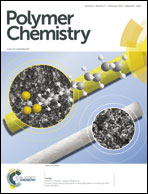Impact of alkyl side chains on the photovoltaic and charge mobility properties of naphthodithiophene–benzothiadiazole copolymers†
Abstract
A series of 5,6-bis(2-ethylhexyloxy)naphtho[2,1-b:3,4-b′]dithiophene and 4,7-bis(3-alkylthiophen-2-yl)-2,1,3-benzo[c][1,2,5]thiadiazole alternating copolymers, PNB-Cn, with different alkyl chains, varying from 8-carbon (C8, 2-ethylhexyl) to 16-carbon (C16, hexadecyl) chains attached onto thienyl moieties were designed and synthesized. The effect of the conjugated copolymer side chain on the photovoltaic and charge mobility properties of organic solar cells (OSCs) and polymer field-effect transistors (PFETs) was investigated. It is found that the short alkyl side chains on PNB-Cn copolymers are favourable for the efficient operation of bulk heterojunction (BHJ) OSCs, while the long alkyl side chains enhance the charge mobility of PFETs. As a result, the BHJ OSCs fabricated from the blend of PNB-C2,6 and PC71BM, using diiodooctane as a solvent additive, yielded a power conversion efficiency of 4.8% and the solution-processed bottom gate bottom contact type PFETs fabricated from PNB-C16 exhibited a hole mobility of 3.4 × 10−2 cm2 V−1 s−1 with an on/off current ratio of 106. Our results suggest that copolymers constructed from 5,6-bis(2-ethylhexyloxy)naphtho[2,1-b:3,4-b′]dithiophene and 4,7-bis(3-alkylthiophen-2-yl)-2,1,3-benzo[c][1,2,5]-thiadiazole are very stable, and solution-processable organic semiconductors for application in organic electronics.


 Please wait while we load your content...
Please wait while we load your content...